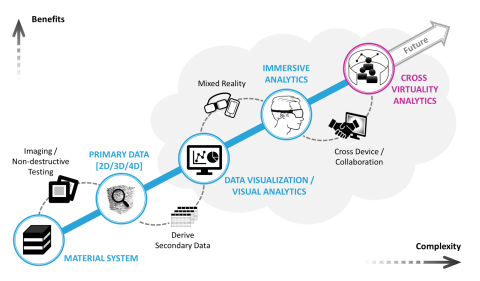Speaker: Prof. Dr. Christoph Heinzl
Abstract
Visualization, analysis and exploration of rich X-ray computed tomography data, including large primary (e.g., projection images or volumetric XCT datasets) and secondary derived data (e.g., segmentation masks, labeled data, abstract or multivariate data), can be cumbersome and at times even impossible in traditional desktop-based setups.
Yet, domain specialists require an in depth understanding of spatial data in its original data domain, considering abstract data on attributes of interest in various representations and levels of detail, despite and precisely because of their large size.
This talk aims to frame some of our research activities in this regard and spans the visualization pipeline from image generation to compression and segmentation, and visualization. Aside from multivariate data analysis, Cross virtuality analytics (XVA) will be addressed as an emerging field in materials science providing novel means for integrative analysis solutions.
XVA enables visual analytics to explore data along the reality-virtuality continuum, individually or collaboratively. It aims to seamlessly integrate suitable visual metaphors, across different devices, and even supports multiple users in solving a joint analysis task. In a few design studies on virtual and augmented reality based immersive analytics techniques as well as a system integrating techniques along the reality-virtuality-continuum, this talk makes the claim, that cross virtuality analytics can provide novel insights into rich XCT data, which have not been possible before.
Bio
Prof. Dr. Christoph Heinzl received his PhD degree in computer science from TU Wien in the field of visualization and analysis of industrial XCT data.
He was awarded the habilitation (venia docendi) from TU Wien in Computer Science in 2022. Aside being professor of cognitive sensor systems at University of Passau, he is leading the research group for knowledge-based image processing and visualization at the Fraunhofer IIS Development center X-ray technology. His research covers visual analysis and visualization of "rich" XCT data, a research domain, in which he published >100 papers, >36 of them peer-reviewed, four book chapters and a patent. He acquired various applied and basic research grants on national and European level (xCTing, X-Pro, AugmeNDT, COMPARE, BeyondInspection, NanoXCT, QUICOM, InteraQCT, ADAM, SmartCT, SimCT, etc.).
